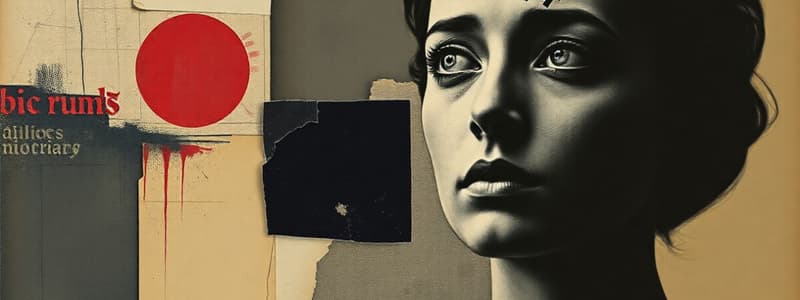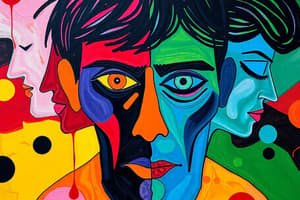Podcast
Questions and Answers
What is a key characteristic of mood disorders?
What is a key characteristic of mood disorders?
- They often lead to improved emotional states.
- They are mild and temporary emotional changes.
- They are always associated with physical ailments.
- They involve significant disturbances in mood. (correct)
Which of the following is NOT considered a cognitive disturbance in depression?
Which of the following is NOT considered a cognitive disturbance in depression?
- Inflated self-esteem (correct)
- Indecisiveness
- Thoughts of death
- Self-criticism
What is considered a physiological disturbance associated with depression?
What is considered a physiological disturbance associated with depression?
- Decreased need for sleep
- Increased goal-directed activity
- Loss of appetite (correct)
- Talkativeness
Which of the following symptoms is specific to a manic episode?
Which of the following symptoms is specific to a manic episode?
Which statement describes a mood disturbance typically seen in individuals with depression?
Which statement describes a mood disturbance typically seen in individuals with depression?
What is the median duration of a recurrent major depressive episode?
What is the median duration of a recurrent major depressive episode?
What characterizes persistent depressive disorder (Dysthymia)?
What characterizes persistent depressive disorder (Dysthymia)?
Which of the following is NOT one of the specifiers for depressive disorders?
Which of the following is NOT one of the specifiers for depressive disorders?
What is a defining characteristic of double depression?
What is a defining characteristic of double depression?
What is the median lifetime number of depressive episodes an individual may experience?
What is the median lifetime number of depressive episodes an individual may experience?
What is the primary characteristic of major depressive disorder?
What is the primary characteristic of major depressive disorder?
How many symptoms must be present for at least two weeks to diagnose major depressive disorder?
How many symptoms must be present for at least two weeks to diagnose major depressive disorder?
Which of the following disorders is characterized by both highs and lows in mood?
Which of the following disorders is characterized by both highs and lows in mood?
What is the average duration of the first depressive episode in major depressive disorder?
What is the average duration of the first depressive episode in major depressive disorder?
Which symptom is NOT a part of the criteria for diagnosing major depressive disorder?
Which symptom is NOT a part of the criteria for diagnosing major depressive disorder?
What is the age of onset typically associated with major depressive disorder?
What is the age of onset typically associated with major depressive disorder?
Which of the following is a characteristic feature of a hypomanic episode?
Which of the following is a characteristic feature of a hypomanic episode?
What distinguishes recurrent major depressive episodes from single episodes?
What distinguishes recurrent major depressive episodes from single episodes?
What distinguishes Bipolar II disorder from Bipolar I disorder?
What distinguishes Bipolar II disorder from Bipolar I disorder?
At what average age does Bipolar I disorder typically onset?
At what average age does Bipolar I disorder typically onset?
What duration must symptoms persist for a diagnosis of cyclothymic disorder?
What duration must symptoms persist for a diagnosis of cyclothymic disorder?
Which of the following is NOT commonly associated with comorbid conditions in bipolar disorders?
Which of the following is NOT commonly associated with comorbid conditions in bipolar disorders?
What is a common characteristic of depressive episodes in both bipolar disorders?
What is a common characteristic of depressive episodes in both bipolar disorders?
Which of the following best describes the onset of bipolar disorder in comparison to depressive disorders?
Which of the following best describes the onset of bipolar disorder in comparison to depressive disorders?
What type of episodes do individuals with cyclothymic disorder experience?
What type of episodes do individuals with cyclothymic disorder experience?
After what age is it considered rare to develop bipolar disorder?
After what age is it considered rare to develop bipolar disorder?
What characterizes the seasonal pattern of depressive episodes in individuals with seasonal affective disorder (SAD)?
What characterizes the seasonal pattern of depressive episodes in individuals with seasonal affective disorder (SAD)?
Which of the following symptoms is NOT associated with Premenstrual Dysphoric Disorder (PMDD)?
Which of the following symptoms is NOT associated with Premenstrual Dysphoric Disorder (PMDD)?
What is a primary criterion for diagnosing a manic episode in Bipolar I Disorder according to DSM-5?
What is a primary criterion for diagnosing a manic episode in Bipolar I Disorder according to DSM-5?
Which behavior is indicative of a manic episode in individuals with Bipolar I Disorder?
Which behavior is indicative of a manic episode in individuals with Bipolar I Disorder?
What best describes Disruptive Mood Dysregulation Disorder?
What best describes Disruptive Mood Dysregulation Disorder?
In the context of Bipolar Disorders, what is rapid-cycling?
In the context of Bipolar Disorders, what is rapid-cycling?
What distinguishes ultra-ultra-rapid cycling in Bipolar Disorders?
What distinguishes ultra-ultra-rapid cycling in Bipolar Disorders?
Critics of Disruptive Mood Dysregulation Disorder argue against what aspect?
Critics of Disruptive Mood Dysregulation Disorder argue against what aspect?
What symptom is often associated with increased activity during a manic episode?
What symptom is often associated with increased activity during a manic episode?
What aspect does the 'rapid-cycling specifier' of bipolar disorder focus on?
What aspect does the 'rapid-cycling specifier' of bipolar disorder focus on?
Flashcards are hidden until you start studying
Study Notes
Mood Disorders: General Characteristics
- Mood disorders are serious disturbances in mood, involving extreme sadness (depression) or elation/irritability (mania).
- These disorders are often associated with other problems like panic attacks, anxiety, substance abuse, personality disorders.
Depression
- Marked by great sadness, feelings of worthlessness and guilt.
- Cognitive features include self-criticism, self-blame, indecisiveness, slowed thinking, and thoughts of death/suicide.
- Physiological and behavioural changes include loss or excess of sleep, appetite, and loss of interest and pleasure in activities.
Mania
- A period of elevated or irritable mood lasting at least one week or requiring hospitalization.
- Individuals experience extreme pleasure in every activity.
- Characterized by inflated self-esteem, decreased need for sleep, talkativeness, flight of ideas, distractibility, and increased goal-directed activity.
Hypomania
- Less severe than mania.
- Does not significantly impair social or occupational functioning.
Depressive Disorders: Overview
- Primarily characterized by low mood.
- Include major depressive disorder, disruptive mood dysregulation disorder, persistent depressive disorder (Dysthymia), and premenstrual dysmorphic disorder.
Bipolar and Related Disorders
- Characterized by both highs and lows in mood.
- Include bipolar disorder (Bipolar I and Bipolar II) and cyclothymic disorder.
Major Depressive Disorder
- Presence of severe depression without mania.
- Impairs a person's interest in or ability to engage in normally enjoyable activities.
- Can be recurrent or a single episode.
- Recurrent episodes are separated by at least two months of euthymia.
- Onset is typically in the mid to late 20s.
- The most common psychiatric disorder worldwide.
Symptoms of Major Depressive Disorder
- Must have at least five symptoms for two weeks, including depressed mood or loss of interest and pleasure.
- Other symptoms include: loss of energy, negative cognitive appraisal, sleep difficulties, changes in appetite and weight, difficulty concentrating, and recurrent thoughts of death or suicide.
Duration of Major Depressive Disorder
- The duration of episodes is variable, ranging from two weeks to several years.
- The average duration of the first episode is 2-9 months.
- The median duration of recurrent episodes is 4-5 months.
- The median lifetime number of depressive episodes is 4-7.
Persistent Depressive Disorder (Dysthymia)
- Relatively unchanged long-term depression.
- Symptoms are similar to major depression but fewer in number.
- Lasts for at least two years without symptom relief for more than two months.
- Can persist for 20-30 years.
- Individuals with Dysthymia may experience co-occurring major depressive episodes, referred to as "Double Depression."
Depressive Disorder Specifiers
- Symptoms or characteristics that may or may not accompany a depressive disorder.
- Eight specifiers: with psychotic features (mood-congruent or mood-incongruent), with anxious distress, with mixed features, with melancholic features, with atypical features, with catatonic features, with peripartum onset, and with seasonal pattern.
Seasonal Affective Disorder (SAD)
- Depressive episodes occur during specific seasons(e.g., beginning in late fall and ending with the start of spring).
- In bipolar disorder, depressions might occur in winter and manic episodes in summer.
Premenstrual Dysphoric Disorder (PMDD)
- Characterized by physical symptoms, severe mood swings, and anxiety.
- Includes decreased interest in activities, difficulty concentrating, lack of energy, hypersomnia or insomnia, changes in appetite, and interference with work or relationships.
Disruptive Mood Dysregulation Disorder (DMDD)
- Common in children.
- Symptoms include chronic irritability, anger, aggression, hyperarousal, and frequent temper tantrums that are grossly out of proportion to the situation.
- Distinct from ADHD.
Arguments for DMDD
- Proponents argue that it is necessary as many children are incorrectly diagnosed with bipolar disorder.
Arguments Against DMDD
- Critics argue that temper tantrums should not be considered a mental illness and that labeling could have negative consequences.
Bipolar I Disorder
- Major depressive episodes alternate with full manic episodes.
- Diagnosis requires at least one week or hospitalization for elevated or irritable mood and increased activity.
- Requires three additional symptoms, or four if the mood is only irritable: increased goal-directed activity at work, socially, or sexually, or psychomotor agitation, unusual talkativeness, rapid speech, flight of ideas, less than the usual amount of sleep needed, inflated self-esteem, distractibility, and excessive involvement in pleasurable activities that are likely to have undesirable consequences.
Bipolar I Disorder Specifier: Rapid-Cycling
- Moving quickly in and out of depressive and manic episodes, with at least four episodes within a year.
- Includes rapid switching (direct transition from one mood state to another), ultra-rapid cycling (cycle lengths lasting days to weeks), and ultra-ultra-rapid cycling (cycle lengths less than 24 hours).
Bipolar II Disorder
- Characterized by depressive episodes and hypomanic episodes, but the episodes are less severe than those in Bipolar I disorder.
Onset and Duration of Bipolar Disorders
- The average age of onset is 15-18 years for Bipolar I Disorder and 19-22 years for Bipolar II Disorder.
- Bipolar disorders develop more suddenly than depressive disorders.
- Rare to develop Bipolar Disorder after the age of 40.
- Individuals with bipolar disorder are at high risk of suicide.
Cyclothymic Disorder
- Chronic condition characterized by cycling between hypomanic symptoms and depression.
- Episodes are not intense or long enough to qualify as hypomanic or depressive episodes.
- Persists for at least two years.
Comorbidity with Bipolar Disorders
- Often occurs with other physical disorders such as thyroid disorders, migraines, heart disease, diabetes, and obesity.
- Individuals with bipolar disorder may self-medicate for these illnesses, which can trigger mania or depression.
- Individuals with bipolar disorder also experience other mental disorders like anxiety disorders, eating disorders, ADHD, and substance use disorders.
Studying That Suits You
Use AI to generate personalized quizzes and flashcards to suit your learning preferences.




